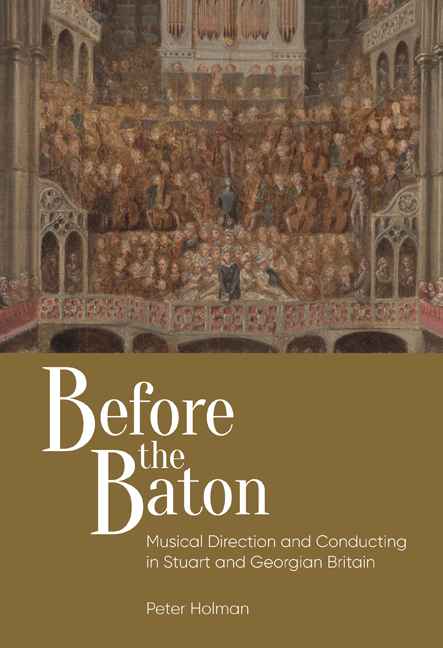Book contents
- Frontmatter
- Dedication
- Contents
- List of Illustrations
- Foreword
- Acknowledgements
- Note to the Reader
- List of Abbreviations
- Prelude To Beat or Not to Beat: The Continental Context
- Part I Directing Choral Music
- Chapter 1 ‘Heard but not Seen’: Leading Anglican Cathedral Music from the Organ
- Chapter 2 ‘With a Scroll of Parchment or Paper, in Hand’: Large- Scale Choral Music
- Chapter 3 ‘Accompanied all along on the Organ by his Own Inimitable Hand’: Handel and the Direction of his Oratorios
- Chapter 4 ‘The Conductor at the Organ’: The Oratorio Tradition after Handel
- Part II Directing Opera and Theatre Music
- Chapter 5 ‘That Ridiculous Custom’: From Devolved Direction to Centralized Time-Beating in Seventeenth-Century Theatre Music
- Chapter 6 ‘Il maestro al cembalo’: Directing Opera and Theatre Music from the Harpsichord
- Chapter 7 ‘A New Discipline and a New Style of Playing’: Directing Opera and Theatre Music from the Violin
- Chapter 8 ‘That Powerful Sovereign, the Conductor’: From the Piano to the Rostrum
- Postlude Superconductors or Semiconductors? Lessons for Today
- Bibliography
- Index
- Miscellaneous Endmatter
Chapter 1 - ‘Heard but not Seen’: Leading Anglican Cathedral Music from the Organ
Published online by Cambridge University Press: 11 September 2020
- Frontmatter
- Dedication
- Contents
- List of Illustrations
- Foreword
- Acknowledgements
- Note to the Reader
- List of Abbreviations
- Prelude To Beat or Not to Beat: The Continental Context
- Part I Directing Choral Music
- Chapter 1 ‘Heard but not Seen’: Leading Anglican Cathedral Music from the Organ
- Chapter 2 ‘With a Scroll of Parchment or Paper, in Hand’: Large- Scale Choral Music
- Chapter 3 ‘Accompanied all along on the Organ by his Own Inimitable Hand’: Handel and the Direction of his Oratorios
- Chapter 4 ‘The Conductor at the Organ’: The Oratorio Tradition after Handel
- Part II Directing Opera and Theatre Music
- Chapter 5 ‘That Ridiculous Custom’: From Devolved Direction to Centralized Time-Beating in Seventeenth-Century Theatre Music
- Chapter 6 ‘Il maestro al cembalo’: Directing Opera and Theatre Music from the Harpsichord
- Chapter 7 ‘A New Discipline and a New Style of Playing’: Directing Opera and Theatre Music from the Violin
- Chapter 8 ‘That Powerful Sovereign, the Conductor’: From the Piano to the Rostrum
- Postlude Superconductors or Semiconductors? Lessons for Today
- Bibliography
- Index
- Miscellaneous Endmatter
Summary
❧ Authority and Leadership in Cathedrals and Collegiate Foundations
A VISITOR to eighteenth-century England accustomed to church music on the continent would have found the practice of its Anglican cathedrals and collegiate foundations strange in several respects – apart from the obvious differences between Anglican and Catholic or Lutheran liturgies. Johann Mattheson (who never visited England but was well informed about its musical life as the secretary of the English resident in Hamburg) wrote in 1713 that the ‘polyphonic music’ (‘Figural-Music’) sung in the Chapel Royal and St Paul's Cathedral did not use instruments or have instrumental passages (‘keine Instrumente oder keine Symphonie’) and was accompanied just by ‘the organ and sometimes a violoncello or theorbo’ (‘der Orgel und etwan einem Violoncello oder einer Theorbe’). However, Mattheson was oversimplifying: English cathedral music was normally only accompanied by the organ, as today, though the Chapel Royal had employed groups of string players to accompany anthems in the reigns of Charles II (1660–85) and James II (1685–88), and large choral and orchestral groups were assembled for successive coronations in Westminster Abbey, a practice later extended to other state occasions and the annual festivals for the Sons of the Clergy (Ch. 2).
Mattheson might have made another distinction between English and continental practice. English composers never developed a proper tradition of polychoral music with writing in eight or more parts, though their cathedral choirs used (and still use) a traditional, simple form of antiphony inherited from the monastic chanting of the psalms. It exploited the placing of the singers in the decani and cantoris stalls (decani and sub-decani in the Chapel Royal) on the north and south sides of the choir. For these reasons time-beating in English church music was much rarer than in other European countries. The norm was for the organist to lead the choir just by accompanying it, helped by the fact that most instruments were placed on the choir screen, equidistant from the stalls on both sides.
Cathedrals and collegiate foundations, including the Chapel Royal, were increasingly marginalised in English cultural life during the eighteenth century. They lost their leading position in musical life as secular concerts developed and because the religious revival of the middle of the century was focused on urban parish churches and chapels rather than cathedrals.
- Type
- Chapter
- Information
- Before the BatonMusical Direction and Conducting in Stuart and Georgian Britain, pp. 43 - 68Publisher: Boydell & BrewerPrint publication year: 2020



